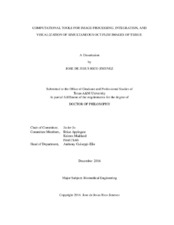| dc.description.abstract | Multimodal imaging systems have emerged as robust methods for the characterization of atherosclerotic plaques and early diagnosis of oral cancer. Multispectral wide-field Fluorescence Lifetime Imaging Microscopy (FLIM) has been shown to be a capable optical imaging modality for biomedical diagnosis oral cancer. A fiber-based endoscope combined with an intensified charge-coupled device (ICCD) allows to collect and split the fluorescence emission into multiple bands, from which the fluorescence lifetime decay in each spectral channel can be calculated separately. However, for accurate calculations, it is necessary to gather multiple gates increasing the imaging time. Since this time is critical for real-time in vivo applications. This study presents a novel approach to using Rapid Lifetime Determination (RLD) methods to considerably shorten this time period.
Moreover, the use of a dual-modality system, incorporating Optical Coherence Tomography (OCT) and FLIM, which simultaneously characterizes 3-D tissue morphology and biochemical composition of tissue, leads to the development of robust computational tools for image processing, integration, and visualization of these imaging techniques. OCTFLIM systems provide 3D structural and 2D biochemical tissue information, which the software tools developed in this work properly integrate to assist the image processing, characterization, and visualization of OCT-FLIM images of atherosclerotic plaques.
Additionally, plaque characterization is performed by visual assessment and requires a trained expert for interpretation of the large data sets. Here, we present two novel computational methods for automated intravascular (IV) OCT plaque characterization. The first method is based on the modeling of each A-line of an IV-OCT data set as a linear combination of a number of depth profiles. After estimating these depth profiles by means of an alternating least square optimization strategy, they are automatically classified to predefined tissue types based on their morphological characteristics. The second method is intended to automatically identify macrophage/foam cell clusters in atherosclerotic plaques. Vulnerable plaques are characterized by presenting a necrotic core below a thin fibrous cap, and extensive infiltration of macrophages/foam cells. Thus, the degree of macrophage accumulation is an indicator in determining plaque progression and probability of rupture. In this work, two texture features are introduced, the normalized standard deviation ratio (NSDRatio) and the entropy ratio (ENTRatio), to effectively classify areas in the plaque with macrophage/foam cell infiltration. Since this methodology has low complexity and computational cost, it could be implemented for in vivo real time identification of macrophage/foam cell presence. | en |


